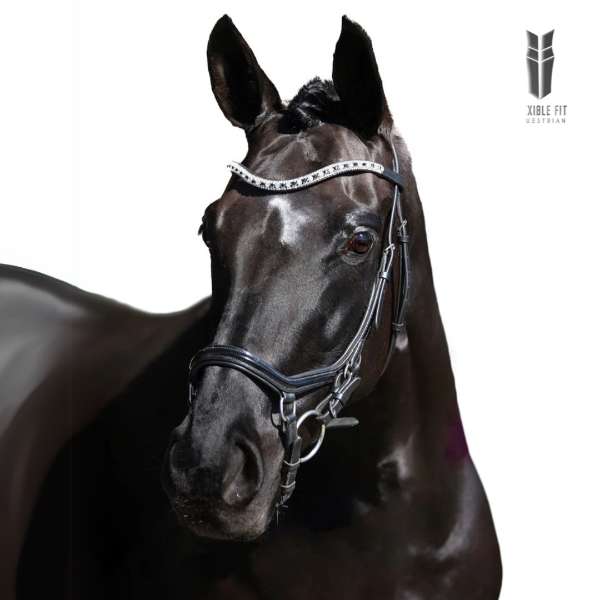Special Features of Horse Bridles
Bridles are essential pieces of tack that play a significant role in your horse’s comfort and performance. While there are various types of bridles available, many come with special features designed to enhance the horse’s fit and overall comfort, which in turn can help improve their performance.
One common feature is anatomically shaped or padded headpieces. These headpieces are specifically designed to alleviate pressure on the poll and behind the ears. Another popular feature is the pressure-relief bridle, which includes anatomically shaped nosebands. These nosebands are designed to avoid the sensitive facial nerves of the horse, offering more comfort. Some bridles also come with modifications to areas like the cheekpieces, where the bit may be cradled differently than in a standard bridle, helping to improve the fit and comfort.
Do These Features Work?
The effectiveness of these special features varies depending on the individual horse. Some horses may experience a noticeable improvement in comfort and performance, while others may not see a difference. As a general rule, more sensitive horses tend to benefit most from these anatomically designed bridles. However, these bridles often come at a higher cost, so it’s advisable to borrow one and test it out before making a purchase.
Discipline Guidelines for Choosing the Right Horse Bridle
When selecting a bridle, it’s important to consider the rules and guidelines for the discipline in which you compete. For example, eventers may require multiple bridles for quick changes between different phases, while dressage riders and jumpers must adhere to specific regulations about the types of bridles and bits permitted. If you’re not competing, it’s still important to choose a bridle that is suited for the specific needs of your riding discipline.
How to Bridle Your Horse: A Step-by-Step Guide
Now that you understand the different types of bridles and their special features, it’s time to learn how to bridle your horse properly. Follow these steps to ensure a smooth and safe process:
Start by putting the reins over the horse’s head and holding them securely. Then, unclasp the headcollar and hang it up to prevent it from getting caught.
Hold the horse’s nose gently with one hand to prevent the horse from raising its head during the process.
Position the bridle: Raise the noseband and ensure the buckles are on the outside, so the bit stays free.
Place the bit in the horse’s mouth: Using your left hand, carefully guide the bit into the horse’s mouth. If the horse resists, use your thumb to gently encourage the horse to open its mouth by slipping it into the gap (where there are no teeth).
Lift the headpiece: Gently place the headpiece behind the horse’s ears, being cautious not to hurt the ears. Move the reins over the neck and adjust the forelock, making sure it doesn’t get caught.
Fasten the latches: First, secure the throat latch, ensuring an upright fist can fit comfortably between the horse’s throat and the latch. Then, fasten the noseband, making sure two fingers fit comfortably between the ridge of the nose and the noseband. If the bridle has a flash strap, follow the same rule for fitting.
Once the bridle is in place, it’s crucial to check that it fits properly.
How to Ensure the Horse Bridle Fits Properly
A bridle that doesn’t fit properly can cause discomfort or harm to your horse. Follow these guidelines to check that the bridle fits well:
Headpiece: The headpiece should not be too tight and should not press against the cartilage of the ears or the neck.
Browband: There should be enough space between the browband and the forehead to ensure comfort.
Cheekpieces: The horse should be able to move its ears freely without pressure on the ear cartilage or jaw. Ensure there’s sufficient space between the bones and the leather.
Noseband: The strap of the noseband should sit below the cheekbones but not directly on top. There should be enough space between the noseband and the cheekbones, with one or two fingers fitting comfortably between them.
Bit: The bit should fit comfortably in the horse’s mouth. It shouldn’t be too wide or too small, and it should not move excessively. Ensure the lips aren’t pinched between the bit and the ring.
If you are using a drop noseband instead of a cavesson, make sure it sits on the bottom of the bone, not on the cartilage, and isn’t too tight. Ensure there is enough space between the bit rings and the noseband rings.
Choosing the Right Horse Bridle for Your Equestrian Discipline
Choosing the correct horse bridle starts with defining the discipline in which the horse is ridden. For instance, dressage horses require bridles that comply with competition regulations, such as the figure-eight snaffle. On the other hand, a simple English snaffle with a flash is not suitable for cross-country or marathon horses. Even for riders who don’t compete, it’s still important to use equipment that suits the horse’s discipline and individual needs.
It’s always a good idea to start with the most basic tack and modify it as needed. Pay attention to how your horse responds to different nosebands, bits, and other features. Some horses may prefer more pressure, while others are more sensitive and need extra padding under the noseband. Horses with mouth issues may benefit from a drop noseband as an alternative to the cavesson.
When selecting a bridle, also consider your own needs as a rider. For example, riders with unsteady hands may benefit from using a flash strap to secure the bit, preventing it from shifting uncomfortably in the horse’s mouth. Aesthetic preferences also play a role, with conventional wisdom suggesting that bulkier bridles look better on horses with bulkier heads.



































